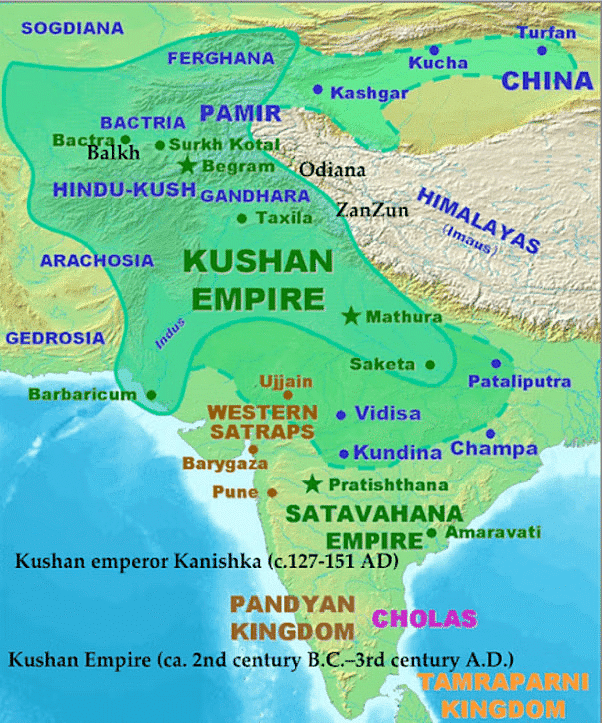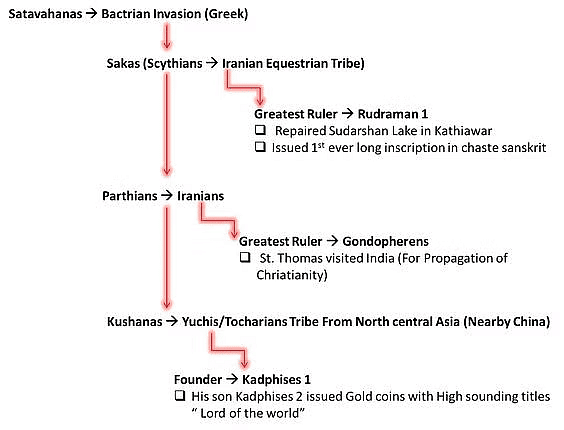Old NCERT Summary (RS Sharma): Central Asian Contacts & their Results | History for UPSC CSE PDF Download
| Table of contents |

|
| The Indo Greeks |

|
| The Sakas |

|
| The Parthians |

|
| The Kushans |

|
| Impact of Central Asian Contacts |

|
The era commencing around 200 B.C. did not witness the emergence of a grand empire comparable to the Mauryas. However, it stands out for the close and extensive interactions between Central Asia and India. In regions like eastern India, central India, and the Deccan, the Mauryas gave way to indigenous rulers such as the Sungas, the Kativas, and the Satavahanas. Conversely, in north-western India, the Mauryas were succeeded by various ruling dynasties originating from Central Asia.
 Indo Greeks
Indo Greeks
The Indo Greeks
Around 200 B.C., a series of invasions occurred, with Greeks crossing the Hindukush and initially ruling Bactria south of the Oxus River in north Afghanistan.
Successive invaders ruled on parallel lines due to the weakness of the Selucid empire in Bactria and Parthia, exacerbated by Scythian pressure.
Scythians, unable to advance into China due to the Great Wall, redirected their focus to neighboring Greeks and Parthians, leading Bactrian Greeks to invade India.
The Greeks, known as Indo-Greeks or Bactrian Greeks, were the first to invade India, occupying a substantial part of north-western India, reaching Ayodhya and Pataliputra.
Indo-Greeks failed to establish a unified rule in India, with two Greek dynasties ruling north-western India simultaneously.
 Indo Greek Territory
Indo Greek Territory
Menander (Milinda), a prominent Indo-Greek ruler, had his capital in Sakala (Sialkot) and invaded the Ganga-Yamuna doab. He converted to Buddhism by Nagasena (Nagarjuna), leading to recorded discussions in the "Milinda Panha" or "The Questions of Milinda."
Indo-Greeks were notable for issuing coins definitively attributed to the kings, unlike early punch-marked coins. The introduction of gold coins by Indo-Greeks continued and expanded under the Kushans.
Greek rule left a lasting impact on Indian history by introducing Hellenistic art features in the north-west, giving rise to Gandhara art.
The Sakas
Greeks were succeeded by the Sakas, who controlled a larger part of India.
Five branches of the Sakas settled in different parts of India and Afghanistan.
One Saka branch settled in Afghanistan, another in Panjab with Tamla as its capital.
A third branch ruled in Mathura for about two centuries.
A fourth branch established control over western India, lasting until the fourth century AD.
Sakas faced little effective resistance in India until around 58 B.C.
A king of Ujjain effectively fought against the Sakas and drove them out, adopting the title of Vikramaditya.
The Vikrama Samvat era began with Vikramaditya's victory over the Sakas in 58 B.C.
Vikramaditya became a prestigious title, adopted by many rulers in Indian history until the twelfth century A.D.
Rudradaman (AD 130-150), a renowned Saka ruler, ruled over Sindh, Kutch, and Gujarat.
Rudradaman recovered Konkan, the Narmada valley, Malwa, and Kathiawar from the Satavahanas.
Rudradaman was known for repairs to the Sudarshana Lake in Kathiawar and his love for Sanskrit.
Rudradaman composed the first-ever long inscription in chaste Sanskrit, a departure from earlier Prakrit inscriptions.
The Parthians
 Parthian Territory
Parthian TerritorySaka domination in north-western India was succeeded by the rule of the Parthians.
In ancient Indian Sanskrit texts, the two peoples are collectively referred to as Saka-Pahlavas, and they ruled over the region on parallel lines for some time.
Originally, the Parthians resided in Iran and later moved to India.
In the first century, they occupied a relatively small portion of north-western India compared to the Greeks and Sakas.
The most renowned Parthian king was Gongophernes.
In Gongophernes' reign, St. Thomas is said to have come to India for the propagation of Christianity.
Similar to the Sakas before them, the Parthians gradually became an integral part of Indian polity and society.
The Kushans
- Parthians were succeeded by the Kushans, also known as Yuezhi or Tocharians. They were one of the five clans of the Yuechi tribe.
- Kushans, originally nomadic people from the steppes of north-Central Asia near China, first occupied Bactria (north Afghanistan), displacing the Sakas. They later moved to the Kabul valley and Gandhara, crossing the Hindukush and replacing the rule of the Greeks and Parthians.
- The Kushan Empire stretched from the Oxus to the Ganga, covering regions from Khorasan in Central Asia to Varanasi in Uttar Pradesh.
- The commingling of peoples and cultures under Kushan rule gave rise to a new type of culture influencing modern countries.
 Kushan Territory
Kushan Territory
- The Kushans had two successive dynasties - the first founded by a house of chiefs called Kadphises, ruling for 28 years from about A.D. 50, and the second founded by the house of Kanishka.
- Kanishka, the most famous Kushan ruler, started the Saka era in A.D. 78 and provided whole-hearted patronage to Buddhism. He held a Buddhist council in Kashmir, finalizing Mahayana Buddhism doctrines, and was a significant patron of art and Sanskrit literature.
- The successors of Kanishka continued to rule in north-western India until about A.D. 230. Some successors bore typical Indian names such as Vasudeva.
- The Kushan empire in Afghanistan and areas west of the Indus was supplanted by the Sassanian power in the mid-third century A.D. However, Kushan principalities continued to exist in India for about a century, lingering in the Kabul valley, Kapsa, Bactria, Khorezm, and Sogdiana (Bokhara and Samarkand) during the third-fourth centuries.
- Numerous Kushan coins, inscriptions, and terracottas have been found in these areas. Toprak-Kala in Khorezm housed a huge Kushan structure from the third-fourth centuries with an administrative archive containing inscriptions and documents written in Aramaic script and Khorezman language.
 Order of Rule
Order of Rule
Impact of Central Asian Contacts
Structures and Pottery
- The Saka-Kushan phase marked advancements in building activities.
- Burnt bricks and tiles were used for flooring and roofing, possibly not influenced from outside.
- Construction of brick wells was notable.
- Pottery included red ware, both plain and polished, with distinctive pots like sprinklers and spouted channels.
Trade and Technology
- Sakas and Kushans enriched Indian culture, contributing to society after settling in India.
- They introduced better cavalry, riding horse, reins, and saddles, impacting Buddhist sculptures.
- Military technology spread, influencing local rulers against former conquerors.
- The Kushans controlled the Silk Route, benefiting from trade and issuing gold coins.
Polity
- Feudatory organization developed with foreign rulers imposing their rule on native princes.
- Kushans adopted titles like "king of kings," indicating supremacy over numerous small princes.
- Divine origin of kingship strengthened, with kings being called sons of god.
- Satrap system and hereditary dual rule were introduced, reflecting less centralization.
New Elements in Indian Society
- Foreign rulers, like Greeks, Sakas, Parthians, and Kushans, assimilated into Indian society, becoming Kshatriyas.
- Manu explained Sakas and Parthians as fallen Kshatriyas, considered second-class.
Religion
- Some rulers adopted Vaishnavism or Buddhism.
- Mahayana Buddhism emerged, emphasizing worship of Buddha images, facilitated by Kushan patronage.
- Foreign rulers contributed to changes in Buddhism.
Gandhara Art
- Foreign princes became enthusiastic patrons of Indian art and literature.
- Gandhara art, a blend of Indian and Graeco-Roman styles, influenced the depiction of Buddha images.
- Mathura also produced significant sculptures during this period.
Literature and Learning
- Sanskrit literature flourished, with Rudradaman's inscription as an early example.
- Asvaghosha, under Kushan patronage, wrote the Buddhacharita and Saundarananda.
- Mahayana Buddhism led to the composition of numerous avadanas in Buddhist-Hybrid Sanskrit.
Science and Technology
- Indian astronomy and astrology were influenced by Greek ideas.
- Medicine, botany, and chemistry advanced with Charaka and Susruta's contributions.
- Technology saw the influence of Central Asians, possibly introducing leather shoe-making and advancements in glass working.
Overall Impact:
Foreign influences enriched various aspects of Indian society, culture, and technology during the Saka-Kushan phase.
|
216 videos|855 docs|219 tests
|
FAQs on Old NCERT Summary (RS Sharma): Central Asian Contacts & their Results - History for UPSC CSE
| 1. Who were the Indo Greeks? |  |
| 2. Who were the Sakas? |  |
| 3. Who were the Parthians? |  |
| 4. Who were the Kushans? |  |
| 5. What was the impact of Central Asian contacts on the Indian subcontinent? |  |
















